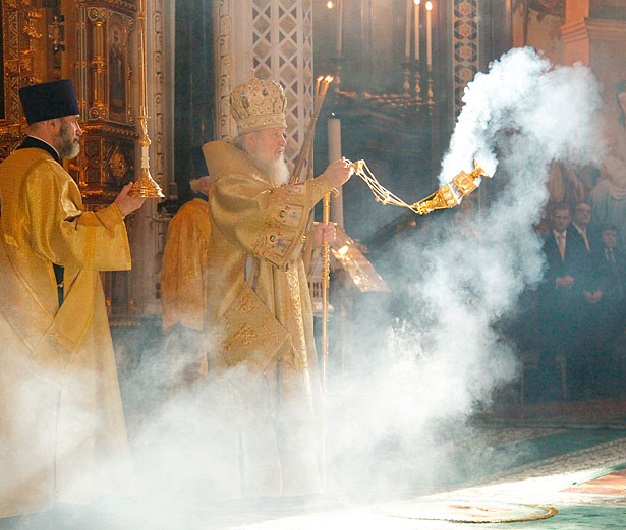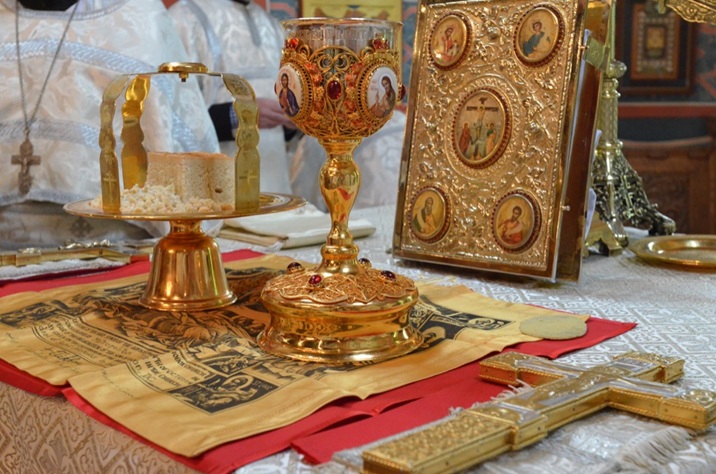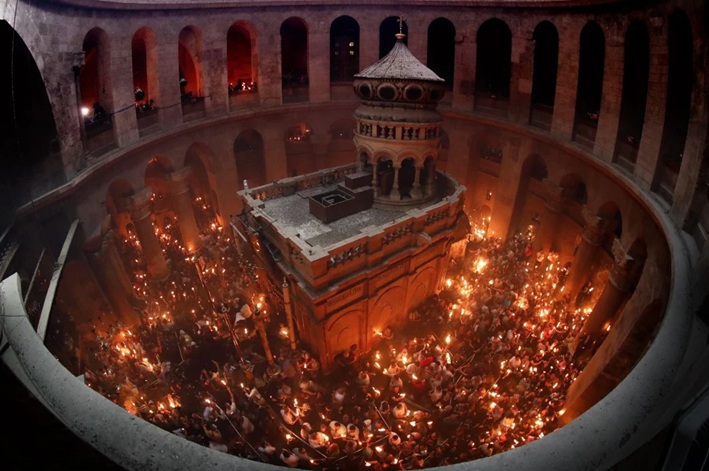ORTHODOX DIVINE LITURGY LIVESTREAMS IN ENGLISH

Biblically Accurate Worship Fulfilling the Liturgy of Moses
If you are unable to regularly visit a parish in person, or if you would like to assess different liturgical rites, below is a collection of active livestreaming options in English from most of the primary liturgical rites of Holy Orthodoxy that trace back to the Apostles and their successors (missing is the Armenian Rite, and some obscure Western Rites). All of these rites are based upon and developed from the Liturgy of St. James, which was patterned upon the liturgical revelation that Christ gave to him after his resurrection. That is, Christ showed him the pattern of the fulfilled Divine Liturgy in the heavenly tabernacle which is now able to be manifested locally in time and space through Christ's established ministerial priesthood after the Order of Melchizedek. This combines and supersedes both the Synagogue and Temple liturgies by fulfilling all the promises of the first covenant as explained in St. Paul's epistle to the Hebrews. The variances in each of the rites below represent local custom related to dialect and culture (i.e. style of chant). However, their common source should be made highly evident through their identical outlines matching the description given by St. Justin Martyr in AD 150 (see Chapters 65-67 of his First Apology), their overlapping of many prayers, hymns and psalms, the similar architecture in each of the Orthodox Temples, and the absolute sense of reverence underlying each rite.
Note that most of the Orthodox world still speaks dialects of Greek, Aramaic, Church Slavonic, and other historic languages, where as English is a minority. Only in the secular world has English become the dominant language. Nevertheless, I hope the following will be sufficiently edifying for you.
For each rite I provide a document or webpage containing the main Liturgical Text for the services, and when available, the Daily or Weekly Propers, which are the variable texts of the services (i.e. the specific hymns, Scripture readings, and prayers appointed for the day).
The first three rites listed belong to Canonical Chalcedonian Orthodoxy (i.e. The Holy Orthodox Church in its fullness), with the European Slavonic Chant of the Byzantine Rite considered primary for English speakers. The reason for this is threefold. First, given its European origin, it is an easy style of chant for native English speakers to adopt while maintaining an unparalleled beauty. Second, it is part of the original Orthodox mission to North America coming first through Alaska. Third, I consider the Byzantine Rite to be the most thoroughly developed of all the liturgical rites due to its proximity to the original central hubs of Christianity in the middle east before their oppression by Islam (which took until AD 1453 to complete). Furthermore, even after the Islamic conquest of the middle-east where the Antiochians to this day continue to suffer tremendously, the Byzantine Rite was maintained and further enriched in the new stronghold of Holy Orthodoxy, the Russian Empire (where Slavonic Chant was developed from Byzantine Chant), right up until the communist revolution of the 20th century. In comparison to this, the Latin Rite suffered from the fall of Rome in AD 410 and the subsequent political turbulence of Western Europe that kept it separated from the rest of Christianity (this is part of why Roman catholicism developed incorrectly on its own, breaking with the east in AD 1054, and becoming so legalistic and corrupt that they caused the Protestant reformation in the 16th century). Down in Africa, the Coptic Rite suffered from the early rise of Islam beginning AD 639, and over in the Persian empire and beyond, the East Syriac Rite suffered from the relentless persecution that the Church of the East underwent by being outside the borders of the Roman-Byzantine Empire (which legalized Christianity in AD 313, although it took until AD 380 for renewed persecution to stop). As the foremost liturgical rite for Canonical Orthodoxy, four options are given for each style of chant in the Byzantine rite. Please note, however, that there is some liturgical compromise in Antiochian Churches due to a variety of reasons beyond the scope of this page. Nevertheless, although European Slavonic Chant and its services are recommended as your primary option, Antiochian Byzantine Chant is still beautiful for those who prefer a more middle-eastern style.
The third canonical rite listed is the Latin Rite. Despite the west breaking off from the east in 1054, when Roman catholicism declared papal infallibility at the first Vatican council in 1870, many from the west began reaching out to the East again. Holy Orthodoxy then re-established this rite for those looking to leave the west with its errors, but who were wanting to keep their liturgical heritage when embracing the fullness of Orthodoxy. Although, like the original Orthodox mission to North America, it would have been far more successful and widespread if the stronghold of Holy Orthodoxy wasn't overtaken and brutally persecuted by the atheist communist uprising beginning in 1917, and lasting until the fall of the Soviet Union in 1991. Nevertheless, like the explosion of Orthodox converts currently happening worldwide, the Western Rite may yet see a revival, especially with the highly liberal direction of the Roman catholics today (particularly when we consider their persecution of the Traditional Latin Mass). As a minor rite within Canonical Orthodoxy, three options are given.
The Coptic, Ethiopian, and West Syriac Rites belong to Oriental Orthodoxy, which are groups of churches who became separated from the primary churches of Holy Orthodoxy between the years of AD 451 and 610 due to the political climate of the time and various language barriers. Although separated for around 1500 years, they have retained the faith with remarkable accuracy, and are working towards solving the language barriers and understanding of Christology (the natures and wills of Christ) so that full communion may be re-established with Canonical Orthodoxy (they are very close). Two options are given for each rite.
The East Syriac Rite belongs to the Church of the East, which has suffered more isolation and persecution than any other historical church, thus being crowned the title, The Martyred Church. Due to its presence in the Persian Empire, contact with the rest of Holy Orthodoxy became increasingly sparse beginning in the 400's, with the last communion shared in AD 628. Although not present at the Council of Chalcedon, they confess Chalcedonian Christology, and despite Islamic persecution destroying their iconography, they have a rich heritage of icons (see the archive of posts on the East Meets East blog for a thorough explanation of both these points). If persecution wasn't enough, they experienced a complex web of schisms with competing lines in and out of communion with Rome from 1553 until 1830, creating the Chaldean catholic church. Although the traditionalists, now known as the Assyrian Church of the East, were unified since 1830, they experienced an old calendar schism in 1968, creating the Ancient Church of the East. Nevertheless, the Assyrian Churches are also taking steps towards reestablishing communion with Holy Orthodoxy. While English is scarcely spoken in their services, two options are given for the East Syriac Rite: one from the Assyrian Church of the East (their services will line up with the liturgical text linked), and the other from an off-shoot of the Ancient Church of the East (who provides the text on the livestream itself).
May you be blessed and edified by the following weekly services, and may they inspire you to seek out the fullness of Holy Orthodoxy so that you may experience Christ in all His glory for the healing of soul and body unto life everlasting. Amen.
Byzantine Rite
(European Slavonic Chant)
**Liturgical Texts and Daily Propers**
St. Nicholas Orthodox Church
St. Tikhon's Orthodox Monastery - (FB)
St. Herman of Alaska Orthodox Church - (FB)
Holy Martyr Peter the Aleut Orthodox Church
Byzantine Rite
(Antiochian Byzantine Chant)
**Liturgical Text and Daily Propers**
St. Nicholas Orthodox Church
St. Mary Orthodox Church - (FB)
St. John Chrysostom Antiochian Orthodox Church
Saints Peter and Paul Antiochian Orthodox Christian Church
Latin Rite
(Western Gregorian Chant)
**Liturgical Text and Full Service Book**
St. Michael Orthodox Church
St. Peter Orthodox Church - (FB)
St. Patrick Orthodox Church - (FB)
Coptic Rite
(Alexandrian Coptic Chant)
**Liturgical Texts**
Church of the Virgin Mary
St. Mary and St. Mark Coptic Church
Ethiopian Rite
(Ethiopian Zema Chant)
**Liturgical Text**
St. Paul Ethiopian Orthodox Tewahedo Church
Virgin Mary Ethiopian Orthodox Tewahedo Cathedral
West Syriac Rite
(Indian Malankara Chant)
**Liturgical Text**
St. Thomas Orthodox Cathedral
St. Ignatius Malankara Jacobite Syriac Christian Cathedral
East Syriac Rite
(Chaldean Assyrian Chant)
**Liturgical Text and Weekly Propers**
Saints Peter and Paul's Church - (FB)
Christ the Good Shepherd Church - (FB)
---------------------------------------------------------------------------

********************************* ********************************* *********************************
WORLDWIDE ORTHODOX CHURCHES BY NUMBER

300 Million Orthodox Faithful Worldwide
(including all missions and jurisdictions not listed below)
If the above services in English are insufficient for you, below are links to the social media of Orthodoxy worldwide (the most active Jurisdictional or Patriarchal Facebook, YouTube, or website available), which I hope will demonstrate the universality of the original Church, and give you a sense of connection to something much larger than yourself. This should be in stark contrast to the isolated feeling of relying on your own private interpretations of Scripture as the sole rule and authority in your life, and the very small clusters of people you may have associated with in the Torah movements (weather in person, or worse, exclusively online).
Please note that these are most of the original Orthodox Churches by geographical area, and that many of these Churches have jurisdictions or missions in other countries which overlap with one another due to the current complexity of immigration worldwide. This is especially apparent in North America where nearly every original Orthodox jurisdiction now has several diocese across the continent (meaning that the number of Orthodox in America is somewhere between 6 and 10 million people). However, the original mission to North America is now an autocephalous Church, the Orthodox Church in America, and therefore is the only Church on the continent that I have chosen to list (with the exception of the Russian Orthodox Church Outside of Russia, but this exists worldwide). Having that said, most (but not all) cross jurisdictional Churches are listed on the Orthodox World directory.
Note also that schismatics who label themselves as "true" or "genuine" (when in reality, they are just fundamental protestants dressed up in Orthodox vestments) are not included in these lists. It must be further mentioned that several notable Orthodox jurisdictions and those under them are omitted on purpose for reasons that exceed the scope of this page. Likewise, any Uniates who have decided to come under the self-proclaimed "universal jurisdiction" of Rome are omitted for what I hope are obvious reasons.
Jurisdictions are listed in order of size and prominence.
EASTERN ORTHODOX (~177M)
Russian Orthodox Church - 110M
Romanian Orthodox Church - (YT) - 19M
Serbian Orthodox Church - (YT) - 12M
Bulgarian Orthodox Church - 10M
Ukrainian Orthodox Church - (YT) - 10M
Antiochian Orthodox Church - (YT) - 4M
Georgian Orthodox Church - (YT) - 4M
Moldovan Orthodox Church - (YT) - 3M
Macedonian Orthodox Church - 2M
Albanian Orthodox Church - 700K
Polish Orthodox Church - 600K
Orthodox Church of Jerusalem - (YT) - 500K
Russian Orthodox Church Outside of Russia - (YT1) - (YT2) - (YT3) - (YT4) - 400K
Orthodox Church in America - (YT) - 100K
Orthodox Church of the Czech Lands and Slovakia - (YT) - 75K
Orthodox Church in Japan - (YT) - 30K
Estonian Orthodox Church - 30K
Latvian Orthodox Church - 20K
Chinese Orthodox Church - (YT) - 15K
ORIENTAL ORTHODOX (~62M)
Ethiopian Orthodox Church - (YT) - 37M
Coptic Orthodox Church - (YT) - 10M
Armenian Apostolic Holy Church - (FB) - (YT) - 9M
Eritrean Orthodox Church - 2M
Indian Orthodox Church - (YT) - 2M
Syriac Orthodox Church - (YT1) - (YT2) - 1.5M
OTHER (~600K)
Holy Apostolic Catholic Assyrian Church of the East - (YT) - 500K
Ancient Church of the East - (YT) - 100K
FIRST CLAIMED PATRIARCHATES OF CHRISTIANITY IN ORDER
If you are interested in the first claimed Patriarchates of territories worldwide, please refer to the list below. The Patriarch is the highest order of Bishop in the Church and is proclaimed when an area has reached a significant level of development and influence. Bishops are important because they are the lead Presbyters who are consecrated to be the Apostolic Successors in a particular area, and thus represent the Apostles as icons of Christ ("He who hears you hears Me, he who rejects you rejects Me, and he who rejects Me rejects Him who sent Me.” as Christ our Lord said to the Apostles whom He ordained and sent out in Luke 10:1,16). Bishops within an area then order themselves accordingly (Chorbishop, Archbishop, Metropolitan, Patriarch), and govern together in a conciliar manner as we read in Acts 15, thus allowing the Holy Spirit to work freely. They not only hold each other accountable, but remain in communion with other Orthodox Bishops worldwide who provide another level of accountability, meeting together in Ecumenical Council as needed. It is therefore the case that a Bishop, regardless of order, cannot leave or break communion with his fellow Bishops and still be Orthodox or part of the Church. This is why, when the Patriarch of Rome broke communion with all other historic Patriarchs in 1054, it was Rome who left the Church and in one sense actually became Protestant before the rest of Protestantism came into being (because of this, any claim of new territory by Rome since then is not included in the list below). This is in stark contrast to when communion is suspended for a time between individual jurisdictions (creating a minor schism) until a canonical issue (usually of church governance) may be sorted out (i.e. the current schism between Moscow and Constantinople). This can be likened to when Paul and Barnabus split for a time in Acts 15:36-40.
Patriarch of Antioch (patriarchate established in the 1st Century, officially recognized in 325)
Patriarch of Alexandria (patriarchate established in the 1st Century, officially recognized in 325)
Patriarch of Rome (patriarchate established in the 1st Century, officially recognized in 325 until 1054)
Patriarch of Jerusalem (bishops since the 1st century, patriarchate established and recognized in 451)
Patriarch of Constantinople (bishops since the 1st century, patriarchate established in 381 and officially recognized in 451 [Constantinople is labeled New Rome in 330])
Patriarch of Carthage (2nd Century - 1076)
Patriarch of Persia (Seleucia-Ctesiphon - bishops recognized by the wider church since 280, catholicos established in 315, title of patriarchate added and recognized in 409/421)
Patriarch of Armenia (since 301, but subordinate until independence with Constantinople and Rome in 554 and 610)
Patriarch of Egypt (since 451 [Coptic Pope of Alexandria])
Patriarch of Syria (since 518 [Syriac Patriarch of Antioch and All the East])
Patriarch of Bulgaria (since 919)
Patriarch of Georgia (since 1010)
Patriarch of Serbia (since 1346)
Patriarch of Moscow (since 1589 [Moscow is labeled Third Rome as early as 1393])
Patriarch of India (since 1912 [Catholicos of the East and Malankara Metropolitan])
Patriarch of Romania (since 1925)
Patriarch of Ethiopia (since 1959)
Patriarch of Eritrea (since 1994)
Note that the dates given are for when the Patriarchates were proclaimed, and that these Churches were in existence long before then.
For more information, please see this extensive list of the current Patriarchs sitting in the Historical Sees established by the Apostles or their successors, and other Primates of self-governing Orthodox Churches by clicking here.



